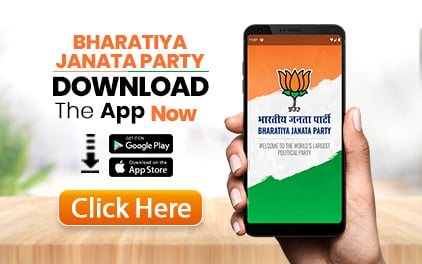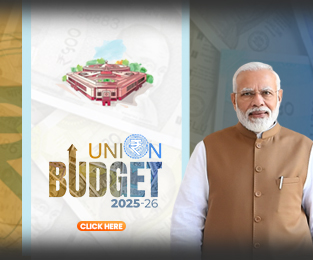A PATRIOTIC PILGRIMAGE: To commemorate the Golden Jubilee of India’s Independence, May-July 1997
(Excerpted from Shri Advani’s autobiography MY COUNTRY MY LIFE)
Lord Macaulay once cynically remarked that an acre in Middlesex is better than a principality in Utopia. Hard-boiled politicians may be inclined to agree with this dictum, and scoff at dreamers. But independent India is acutely conscious of the fact that it is the dreams of visionaries like Vivekananda, Aurobindo, Tagore and Gandhi that have inspired the nation during the freedom struggle and finally helped liberate it. These great seers, each in his own inimitable way, described the India of their dreams—a great and glorious India, commanding the respect of the entire world. I hold that India’s Constitution-makers very ably encapsulated these dreams of theirs in the Preamble to the Constitution, which beckons to the day when all Indian citizens would secure:
Justice, social, economic and political;
Liberty of thought, expression, belief, faith and worship;
Equality of status and of opportunity; and to promote among them all;
Fraternity assuring the dignity of the individual and the unity of the Nation’.
As a political activist, I identify myself completely with this sublime, yet eminently attainable, vision of future India. I longingly look forward to its realisation.
(From my article in The Illustrated Weekly of India, Independence Day special, 1987)
Ten years after I wrote this, in 1997, an event occurred that gave me an opportunity to propagate my vision through a unique
political campaign—the golden jubilee of India’s Independence, which ushered in a mood of patriotism all over the country.
Sometime in February, I called a meeting of my colleagues in the party office to discuss how the BJP should commemorate 1997. After considering several suggestions, we decided to pay homage to all the heroes and martyrs of the freedom movement by visiting places associated with them across the country. My young team of offi ce-bearers and other colleagues soon translated the idea into a concrete plan in the form of a nationwide road journey called the Swarna Jayanti Rath Yatra: Rashtrabhakti Ki Teerth Yatra (A Patriotic Pilgrimage). Travelling to places sanctifi ed by the struggles andsacrifices of the heroes of the freedom movement was akin to undertaking pilgrimage. I felt this would help me strengthen my own as well as my
party’s, nationalist and idealist moorings.
Three factors, however, seemed problematic: timing, climate and the sheer number of places we would need to visit. The yatra had to be undertaken before 15 August, but only after the schools and colleges had completed their examinations. It also had to be concluded before the onset of the rains, which arrive sooner in the south than in the north. Since all the states needed to be covered, the yatra would take not less than two months. In other words, I needed to be on the road in the peak
of the forbidding Indian summer—and the condition of roads then was not half as good as it is today. This concerned some of my colleagues who were doubtful of subjecting me to this strain and also because I as to soon turn seventy. I was, however, fi rm and decided to go ahead with the yatra.
THE YATRA’S RAISON D’ETRE
There were a couple of reasons why I agreed to undertake this campaign. The first was personal: the golden jubilee of India’s Independence was a highly emotional occasion for me. However, it was as much a time for introspection as celebration. Therefore, it was also necessary to take stock of the successes, shortcomings and failures of the fi rst fi fty years of free India, and, simultaneously, to catalyse a serious debate on the content and direction of India’s future development.
The second reason was political: I wanted to project the BJP as a party committed to good governance. Although India had attained swaraj or self-governance in 1947, it had not been transformed, even after fifty ears, into su-raj or good governance. Consequently, people had started perceiving all politicians as unprincipled, unscrupulous, self-seeking and power-hungry. It was necessary, therefore, for the BJP to rededicate itself to a loftier goal for being in politics, an ideal that went far beyond the immediate goal of pursuit of political power and linked itself to the task of freeing India from the yoke of hunger, fear and corruption. The government of I.K. Gujral, like that of H.D. Deve Gowda, was showing clear signs of early mortality. The prospect of another mid-term parliamentary poll was looming large, and the Congress party, which had lost power, was getting discredited as a destabiliser. On the other hand, the fact that Atal Bihari Vajpayee’s government could not last beyond thirteen
days, in spite of the BJP having emerged as the single largest party in the1996 parliamentary elections, had greatly disappointed the people. They were craving for stability and better governance. The situation was, thus, rapidly turning in BJP’s favour. I reckoned that a nationwide yatra at this time would serve both my purposes.
My young party colleagues—Pramod Mahajan, M. Venkaiah Naidu, Sushma Swaraj, K.N. Govindacharya, Narendra Modi and Sadhvi Uma Bharati—began preparations for the yatra, which was to take place in four continuous phases in fi fty-nine days, from 18 May to 15 July, covering a distance of over 15,000 kilometres through as many as twenty-one states and union territories, making it by far the longest and widest mass contact programme undertaken by any political party since Independence.
(The seven North-Eastern states, where the rains arrive much earlier than elsewhere, had to be covered separately after Independence Day.) I addressed 750 scheduled public meetings, besides speaking to people at several thousand unscheduled wayside receptions in villages and hamlets. My colleagues later estimated that the yatra established direct contact with as many as two crore Indians from the time of its beginning in Mumbai to its conclusion in Delhi.
I had been cautioned by some people against undertaking this second yatra, since comparisons with my Ram Rath Yatra of 1990, from Somnath to Ayodhya, would be inevitable. Also, unlike the Ram Janmabhoomi issue, which was religious and hence emotive in nature, a yatra for the golden jubilee celebrations would fail to draw the crowds, they said. In reality, however, the Swarna Jayanti Rath Yatra evoked a stupendously positive response, giving me deep and enduring satisfaction. It also helped me learn a lot about the proud history of India’s freedom movement, which in many places in the country began well before the First War of Independence in 1857. But for this countrywide journey, I would not have known about so many less renowned heroes and martyrs, whose names are a part of the local folklore in every state and whose exploits can inspire the young and the old for generations to come
But the Swarna Jayanti Rath Yatra was not only about India’s past. It was equally about India’s present and future. The campaign enabledme to talk about a wide range of issues of contemporary and future importance—corruption, criminalisation, casteism, communalism, terrorism, poverty, women’s empowerment, education, environment, work culture and economic development guided by the swadeshi principle with a focus on agriculture and employment. Above all, it reinforced my conviction, fi rst formed during the Ayodhya movement, that there is no greater method than a yatra to reach out to the common people in a vast country like ours, and no better way to galvanise the large army of one’s own party workers and sympathisers.
…As I look back at the two months that I was on the road, traversing the length and breadth of India, and honouring the sacred memory of hundreds of martyrs and heroes of our freedom struggle, I feel gratifi ed that the yatra truly lived up to its description: A Patriotic Pilgrimage.



.gif)





